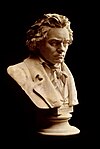| Revision as of 02:37, 11 December 2007 edit70.250.153.117 (talk) →External links← Previous edit | Revision as of 02:38, 11 December 2007 edit undoEsanchez7587 (talk | contribs)33,395 edits Revert to revision 175544980 dated 2007-12-03 19:25:09 by SieBot using popupsNext edit → | ||
| Line 50: | Line 50: | ||
| ==External links== | ==External links== | ||
| *Analysis of the on the Page | |||
| * of Beethoven's Fourth Symphony. | |||
| {{Template group | |||
| |list = | |||
| {{Ludwig van Beethoven}} | |||
| {{Beethoven symphonies}} | |||
| }} | |||
| <!--Categories--> | |||
| ] | |||
| ] | |||
| <!--Other languages--> | |||
| ] | |||
| ] | |||
| ] | |||
| ] | |||
| ] | ] | ||
| ] | ] | ||
Revision as of 02:38, 11 December 2007
Ludwig van Beethoven's Symphony No. 4 in B Flat Major, Op. 60, was written in 1806.
Background
The work was dedicated to Count Franz von Oppersdorff, a relative of Beethoven's patron, Prince Lichnowsky. The Count met Beethoven when he traveled to Lichnowsky's summer home where Beethoven was staying. Von Oppersdorff listened to Beethoven's Symphony No. 2 in D Major, and liked it so much that he offered a great amount of money for Beethoven to compose a new symphony for him. The dedication was made to "the Silesian nobleman Count Franz von Oppersdorf".
Instrumentation
The symphony is scored for flute, 2 oboes, 2 clarinets in B flat, 2 bassoons, 2 horns in B flat and E flat, 2 trumpets in B flat and E flat, timpani and strings.
Form
There are four movements:
- Adagio -- Allegro vivace
- Adagio
- Allegro molto e vivace -- Trio. Un poco meno allegro
- Allegro ma non troppo
The work takes about 33 minutes to perform.
Reception
Although all nine of Beethoven's symphonies are widely performed, the Fourth is less often performed than some of the others. Robert Schumann described Symphony No. 4 as a "slender Greek maiden between two Norse gods", referring to the 3rd and 5th Symphonies, both with towering reputations.
Performance
The sound files are from a performance by the Skidmore College Orchestra.
Template:Sample box start variation 2

Problems playing this file? See media help.
Template:Sample box start variation 2

Problems playing this file? See media help.
Template:Sample box start variation 2

Problems playing this file? See media help.
Template:Sample box start variation 2

Problems playing this file? See media help.
Notes
- Paul Netl (1976) Beethoven Handbook. New York: Frederick Ungar Publishing Co., p. 262
External links
- Analysis of the Beethoven Symphony No. 4 on the All About Ludwig van Beethoven Page
- Full Score of Beethoven's Fourth Symphony.
| Links to related articles | |||||||||||||||||||||||||||||||
|---|---|---|---|---|---|---|---|---|---|---|---|---|---|---|---|---|---|---|---|---|---|---|---|---|---|---|---|---|---|---|---|
| |||||||||||||||||||||||||||||||
